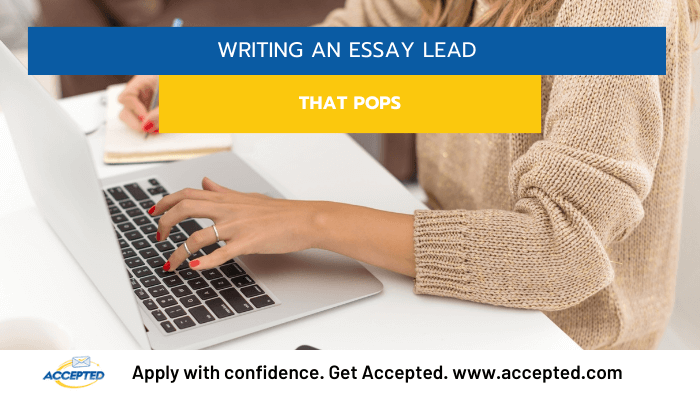|
Writing an Essay Lead That Pops |
||
Writing an Essay Lead That Pops


How many times have you sampled the first few lines of a book and decided, “Nah, this isn’t for me”? Whether you picked the book up in a store or library, or downloaded free sample online, you probably made a pretty speedy decision about whether it would hold your interest.
The human tendency to rush to judgment
Our extremely fast-paced world has trained us to make snap decisions throughout the day, and if, for example, we’re not hooked instantly by an article, book, movie trailer, or song, we’re just a click away from another, more appealing choice. We might move quickly away from someone at a party who begins to bore us and whom we lack the patience to listen to, for even another minute.

Because we have endless choices, we get choosier and choosier about what we’re willing to stick with. These rapid judgments might not be fair, but the “burden of overchoice” in our lives feeds our short attention spans.
Admissions committee members are human. And the pressure of their job forces them to make very quick decisions about whose applications they will invest more time in and whose will merit only an obligatory but cursory review before being set aside as unworthy of serious consideration.
Their reality is truly “so many applications, so little time,” which means that when you are applying to b-school, med school, grad school, or college, you have to capture your reader’s attention with the very first lines of your essay – before they are tempted to just give it that cursory read and move on to the next application. Your very first sentence cannot fall flat. It must reel them into your narrative. Every word counts.
How to hook your essay readers from the beginning
This sounds like a lot of pressure, right? But this is a challenge you can meet successfully. Think of your lead as the beginning of a good fiction story: something is at stake here, something compelling and colorful, something with a punch. Let’s look at a few examples, and you’ll quickly get the point:
“Horns blare as tiny auto rickshaws and bicycle-powered school buses interweave at impossibly close range in the narrow streets of Old Delhi.”
“After a near disaster during my first week as a case manager at a community center for women and children, I discovered that to succeed in my job, I’d have to restrain my anger at how badly things were run in this place.”
“My aunt’s cancer had already metastasized throughout her body by the time she was finally diagnosed correctly – too late for any effective treatment. At that moment, my interest in a career as a science researcher became much more personal.”
“From the age of seven, when I was struggling with simple math problems but acing my spelling tests and already writing simple stories, I knew I was meant to become a writer.”
Notice that three of these four sample leads are personal anecdotes. They offer no details about the writer’s GPA or technical facts about what they researched in the lab. The first lead is so colorful and dramatic that we instantly want to know more about the person who observed the scene. In every case, the lead begins a story that makes the reader sit up and say, “Ah! This is a dynamic person with a compelling voice!”
Your goal is to write an essay that introduces you to the admissions committee and makes them want to get to know you better. You’re way ahead of the game when your essay introduction really shines.
Three components of a strong lead
A strong essay opener will include three key elements:
- The theme or agenda of your essay, offering the first few facts about who you are, what you are interested in doing with your life/career/studies, and/or important influences
- Creative details or descriptions
- Energetic writing that will keep the reader engaged through the rest of the essay
Good leads connect where you’ve been to where you’re going
Let’s look at a few more engaging first lines:
- “It was absolutely pitch black outside when we had to silently leave our home and climb into the back of a truck, beginning our journey to freedom.”
- “Only six months after I launched my start-up, money was flowing… out the window.”
- “Finding a green, scratched 1960s Cadillac in a dump last summer was the moment I realized that mechanical engineering was for me.”
Wouldn’t you want to keep reading to learn the rest of these stories? I would!
Many clients worry that these kinds of anecdotal introductions are too “soft,” too “personal,” or too “creative.” But the right vibrant anecdote can absolutely do the job of being creative, personal, and strong. A compelling lead draws your reader into your story and make them feel involved in your journey. Descriptive language can go a long way to spice up a straightforward story and help the reader follow you from where you began to where you are headed.
How to write a lead that pops
Now that you have read several great examples of attention-grabbing leads, your mind might already be busy generating ideas for your own essay introduction. Write them down. If you don’t have ideas just yet, though, that’s okay – give yourself some time to think. Make a list of turning-point moments in your life that relate to your educational or professional goals. As we have seen, these experiences can be drawn from anywhere: recent or older work experiences, your cultural or family background, or “aha!” moments.
An electrical engineering applicant could describe the first time their rural home suddenly went dark and they realized they had found their professional calling. An MBA applicant might have had a very profound and meaningful experience offering basic financial guidance to a struggling working-class individual, prompting their goal of pursuing a career in the nonprofit sector. A law school applicant might have witnessed a courtroom scene during an internship that inspired them to pursue a certain type of law. The possibilities go on and on.
As you make your list of anecdotes, jot down as many small, precise details as you can about each memory or experience. Why was this moment important on your journey toward your dream career or school? How did you feel at that moment? How did it help shape you? What did it teach you? Were there any sensory details (sights, smells, tastes, touch) that were particularly relevant to those moments?
Then, try starting your essay with the anecdote itself, inviting the reader to share your experience, and add color, personality, and voice.
At the beginning of this post, we pointed out how easy it is to make snap judgments (perhaps unfairly) about a book, article, film, or acquaintance you just met at a party, and to turn your attention away because you weren’t captivated instantly. We end this post asking you to think about all the times you began sampling a book or story and after the first few lines, you simply had to know what was going to happen next. You bought the book or read the story straight through. You want your essay to be one of those proverbial “page-turners” (even if it’s less than one page) that the admissions committee starts reading and can’t put down. You will have earned their full attention, straight through to the end. Once they’re hooked, you can take them anywhere you please.
Still need help finding that “hook” to open your essay? Our admissions pros will guide you to finding that perfect moment. They can help you plan and craft an application that will draw your readers in with a substantive narrative that will inspire them to place your application in the “admit” pile.

By Judy Gruen, former Accepted admissions consultant. Judy holds a master’s in journalism from Northwestern University. She is also the co-author of Accepted’s first full-length book, MBA Admission for Smarties: The No-Nonsense Guide to Acceptance at Top Business Schools. Want an admissions expert help you get accepted? Click here to get in touch!
Related Resources:
- Five Fatal Flaws to Avoid in Your Grad School Statement of Purpose, a free guide
- Three Must-Have Elements of a Good Statement of Purpose
- Proving Character Traits in Your Essays
The post Writing an Essay Lead That Pops appeared first on Accepted Admissions Blog.
[0] Comments to this Article